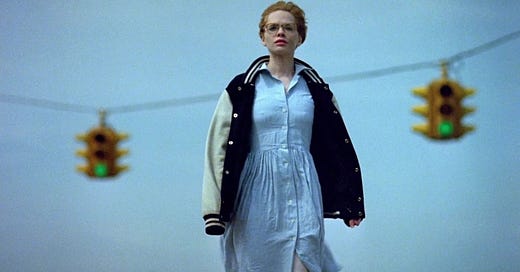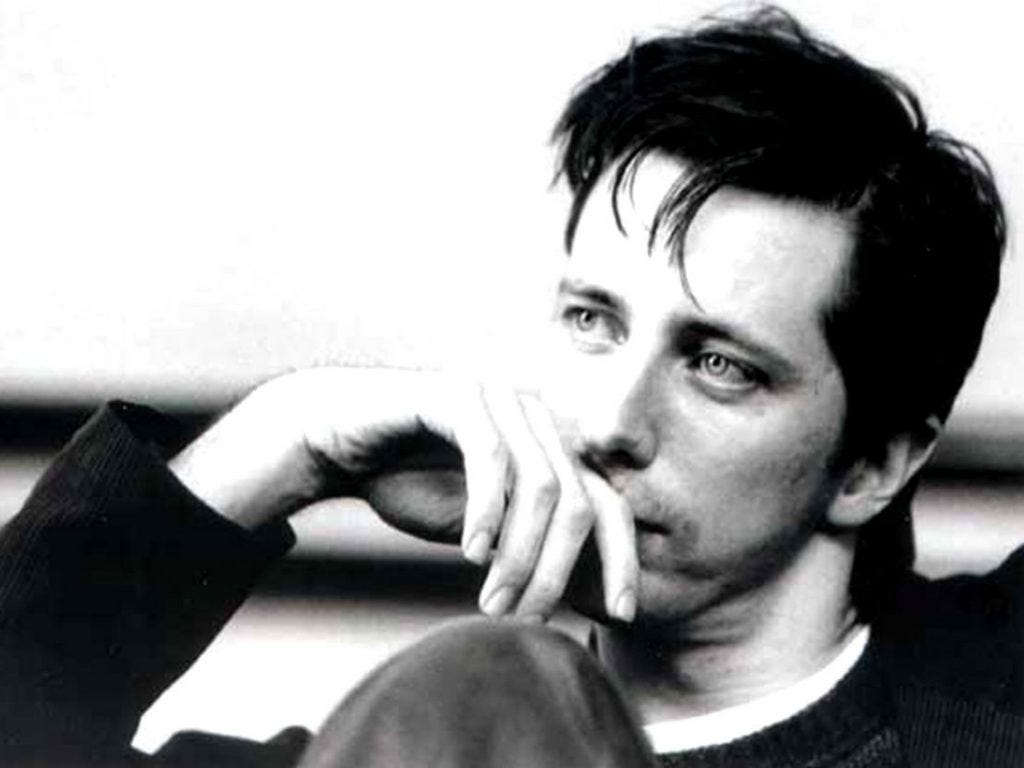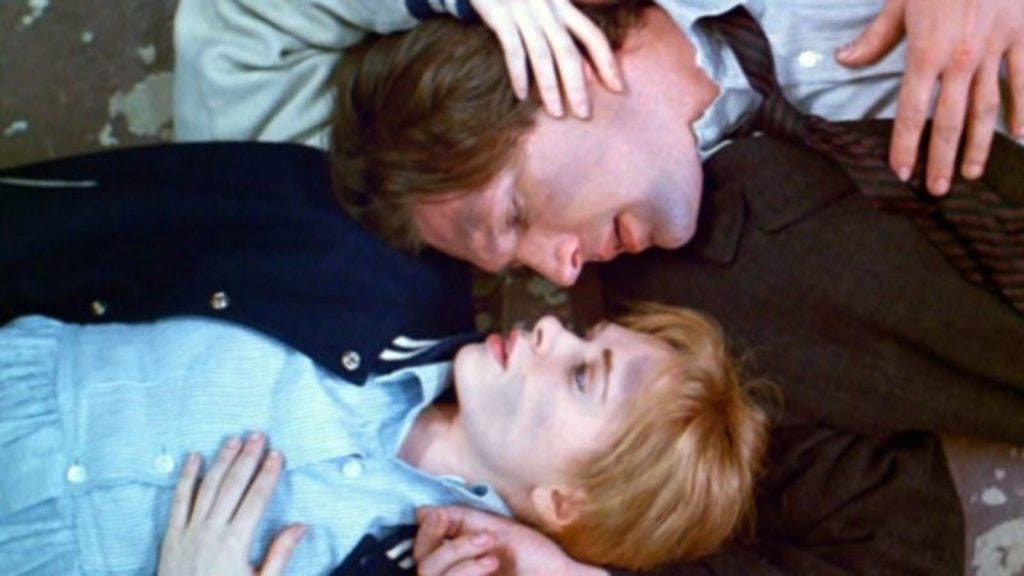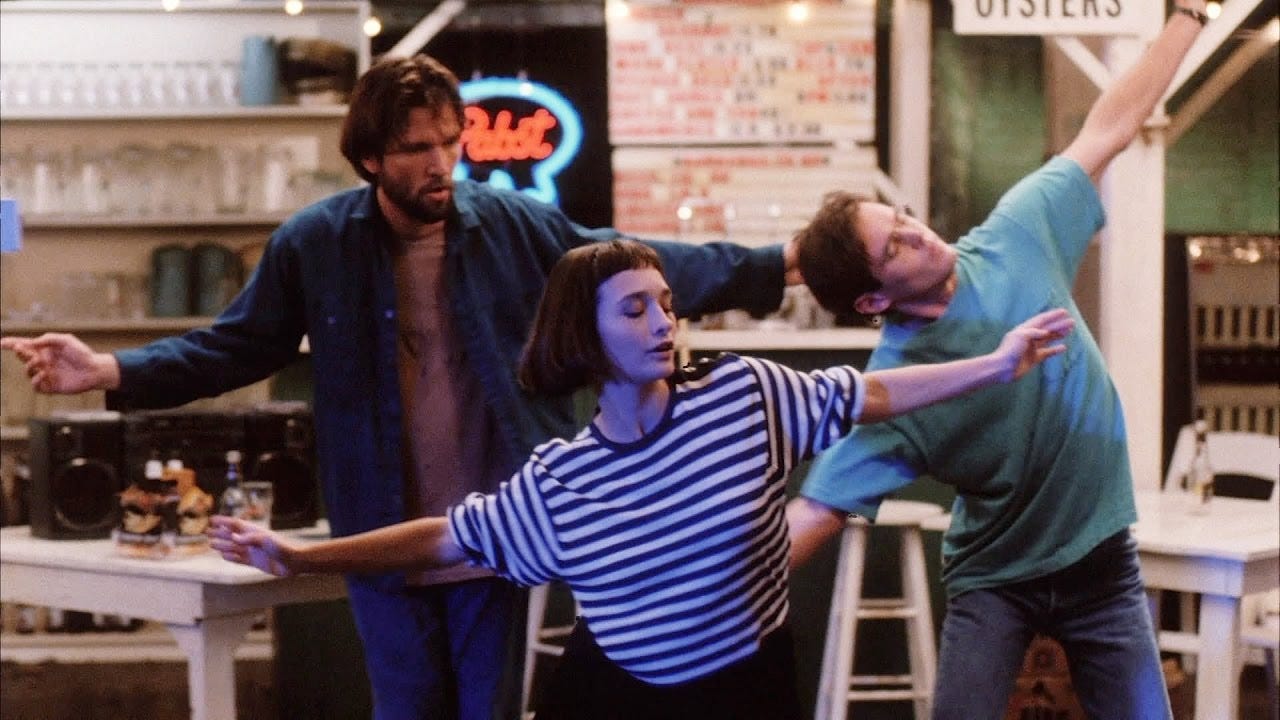"I try not to reach too far for subject matter. I try to make stories out of the stuff of the world I move through. What I do with these commonalities might be a little unusual, but I'm not interested in the exotic. I've wanted my films to provide evidence of my time and place, whereever that might be."
In the 1990s, Hal Hartley passed for it: a deadpan pasticheur from Long Island who liked French movies and poker-faced piquant variations in highly verbal comedies drawing from Godard and Gallic epigrammatists, dropping in complications a la screwball comedy with just a smattering of vulgar provocations. A modest, blunt, elemental visual style. Simplicity and directness. And catchphrases like “There’s no such thing as adventure and romance, only trouble and desire.” Yeah, that becalmed romanticism spoke to me and the yet-younger me inside the movie-mad me. But indie didn’t last.
Hartley nourished a modest following—perhaps only a certain stripe of film critics? A few neurotic romantics here and there across the land?—with his 1989 debut, The Unbelievable Truth and on through Trust, the short feature Surviving Desire, Simple Men and Flirt. While none of those movies made true money, Hartley’s earliest films were distributed by Miramax in that go-go decade for the Weinstein brothers’ first company, and even Sony Pictures Classics got into the mix with the Isabelle Huppert-starring “Amateur” (1994).
Olive Films was helping Hartley publicize his Kickstarter to get his body of work onto Blu-ray in 2018 when we spoke.
So, Hal, you’re reclaiming your library.
Yes. A number of years ago, I decided I wanted to put a little bit of my company’s money into restoring all the films and making them available in whatever is the best way these days. I don’t know what it will be like years from now, what people will be watching movies on, but I want to get them all the films onto high definition, cleaned up and presentable, so I’m sort of like building an encyclopedia.
We did the Henry Fool trilogy in 2017, and we’re doing the next set because the rights came back to me. Year by year, we’ll try to do more, so in maybe five or six years, we might have the entire body of work thus far presentable. This gives you control of your work and its future, but it’s also a labor of love. It’s not a terribly profitable thing at the moment, but it does pay for itself.
Having crowd-sourced projects like these, where people can pre-order these things at sensible prices, that takes a lot of the edge off. We can do a lot of the work and know that there’s an audience, and after that we go out through Amazon all over the world and from my own website. A key thing, of course, to make it viable was subtitling. You probably remember from back in the day, back in the nineties, subtitling was a really complicated and expensive undertaking. It’s still probably the most expensive part of what we’re doing with these DVDs, subtitling them in five different languages, but it’s nowhere near as prohibitive as it used to be before the digital technology. That’s really how I began thinking about it five or six years ago, I just said I have to get past nationally defined distributors, and in some way, I have to distribute directly all over the world at once the same product can meet a lot of the world’s language needs.
I just look for the opportunities, really. I’ve always known that not just my
taste, but also my ambitions are not mainstream, so there’s no reason to, you
know, complain about not getting the work that’s more mainstream.
The first three films, The Unbelievable Truth (1989), Trust (1990) and Simple Men (1992), you said in “True Fiction Pictures and Possible Films,” the 2008 book of conversations with Kenneth Kaleta, “They worked well together, having been made by the same crew all in a line one after another. There’s a consistency of style or attack that they were made almost as if no one was watching.” Did you still have that feeling when you were assembling the materials? Tell me about the process of when you reclaim the rights? Are the original materials in someone else’s hands or someone’s warehouse?
Well, it’s different. I’m spending a lot of time going over the films again, side-by-side, and what strikes me as real differences one from the other, from The Unbelievable Truth to Trust, it was a real change, not simply in acquired skills, more experience, more ambition, more confidence, but an attempt to make a different kind of film. And then after Trust, moving to Simple Men, it was the same thing, you know, trying to make a different kind of film. But I really see that now that there was a more, I hesitate to say “relaxed,” but in The Unbelievable Truth, it was more use of tableaux: let the performers do their thing in the frame, the frame is very carefully set and I’d stand back a little from it. Whereas, Trust, it was more aggressively scripted, there was more aggressive physical activity. The blocking is more aggressively edited, the pace, you know. All that. I was very happy with it but you know. I had done that now, and I don’t think I was thinking like I was doing something terribly original. I was like thinking about melodramas, probably English melodramas, that I liked from the past but that was done and then by the time I was designing Simple Men, I came to understand that I was on new territory.
Were formal choices in the first films pragmatic, in terms of limitations, like time and money and geographical space?
That’s not something I feel when I’m looking at the films now or that I remember. You know, there were always budgetary limitations. The first film, The Unbelievable Truth, was made for very, very little money and so, yeah, my creative strategy was to keep things essential: make fewer shots and put the energy, our creative energy, into the dialogue and the performances within frames that were not too ambitious but were interesting to us.
My favorite cliché—fact?—from lower-budget filmmakers is that dialogue has always been the cheapest special effect.
Yes… Well, it worked for me when I first got interested in making films, it wasn’t long before I was encouraged by everybody, my teachers and friends, they said, you’ve got a knack for dialogue and I did. I was very excited by it!
Viewers and reviewers have drawn influences of comparisons to certain things about Bresson or Godard, but are there subterranean influences on scenes involving dance or slapstick?
Yeah. The early silent movies always excited me, Buster Keaton, in particular Harold Lloyd, but some other things that might not be as pronounced. Like, say, the films of Alan Rudolph, for instance. I discovered his movies in the three or four years before I made my first feature film, and there was something about the way he told stories about the way people talk to each other and their dialogue was not talking to each other, they’re talking around each other.
The great Choose Me.
Yeah, yeah, that blew me away when I saw it. I was the only one renting it from my local VHS place in midtown Manhattan for like a year, again and again, and then the guy says, why don’t you just take it, you’re the only one who ever watches it! So I paid him like ten dollars and I just took it and I was very happy that years later, many years later, I got to become friends with Alan and so I was able to tell him.
Let’s talk about melodramas.
I spent a few days with the students at the University of Indiana and this came up in conversation, but Peter Brook’s film of his own production of Marat/Sade, that is something I forgot how instrumental was to my writing and my conception of blocking and everything. I discovered it a year before I made The Unbelievable Truth. It’s come back again and again, and I watch it like every year. I look at it now and I look at all of my films… It’s like a post-Brechtian thing, that it’s okay to show the artifice, it’s okay. It’s more entertaining, you know, to not pretend that this is real, what’s going on, that we’re making effort to demonstrate something for you. I’ve always liked that about certain kinds of films and theater. I don’t like naturalistic theater—I never go to see that sort of thing—but then one of the people out at Indiana used a word I’d never heard before, “performative.” They said there’s a performative quality to your actors.
I’d never heard that word before, but I knew, yeah, I want the viewer to know what the actors are doing; there’s a reason why they’re taking this pause, why they’re moving this way. It’s that simple. There might be other, more academic ways of talking about it, but for me it was just a gut reaction. Just a sensibility. A taste. I get bored when the story’s trying to appear real, when the reality is performing and addressing real issues—they don’t have to be huge issues—and personal things. I find that much more exciting.
And there are matters of style, of acting style, of filmmaking style, that come into play when anyone’s making films. Some of them are unconscious, but a great gift of the narrative is that where you’re photographing the human face and the human body, it weirdly becomes naturalistic even when you’re doing really strange things. An example I can think of is in The Master, there are things that Philip Seymour Hoffman does, including a foul outburst he has in front of a roomful of genteel people, that aren’t psychological, they’re stylized.
Yeah, yeah. Psychology. I don’t personally spend that much time thinking about psychology when I’m directing the actors or writing.
People sometimes break out into epigrams just like
they break out into song in musicals.
Are there influences in terms of use of dance and movement we might not expect?
Yeah, well, there’s the blatant kind of choreography that people burst out in, dance and stuff like that, Surviving Desire and in Simple Men. That’s why I brought up Peter Brook and Marat/Sade. These people bursting into song, when all the time they’re trying to perform a play to tell you about the French Revolution and it keeps falling, falling apart. There’s that, but the other type of choreography, meaning blocking, how I move people around in the frame in conjunction with what they’re saying. You mentioned Bresson a little while ago… My earlier years, yeah, there was a kind of restraint and this decided physical activity that I was very attracted to. I watched his films very closely and I know even when I’m making a comedy, it’s probably most obvious in Trust, but yeah, Bresson was an influence there, but so was Stanley Kubrick. Both very, very different types of filmmakers, but they were all filmmakers who evidenced certain decisiveness in their shots, their well-rehearsed, well-understood dialogues and physical activity, and even beyond the idea of stylization are not naturalism or anything about psychology.
Kubrick’s films tell you what they are as they begin, by having a created world, through the imposed style, the choice of settings. That’s the case with your films. Kubrick said you have about eight minutes to seduce a viewer into a new world before they walk out or shut off the film.
Your other example, Bresson, I - I mean, just, A Man Escaped: a man escaped. The title tells you what the whole movie is going to be. I think in the original French, it’s just a statement, a man condemned to death will escape! That takes all the attention off the old-fashioned sense of [drama]: but it’s one of the most beautiful and riveting movies I’ve ever seen. Even though you know he’s going to escape, you’re watching with an attention to his activities that you wouldn’t have if you were worried about whether he was going to escape.
From Simple Men: “There’s no such thing as adventure and romance, there’s only trouble and desire.” It sounds like something you would put on a billboard, but it’s riveting in its own goofy way.
There was something about juxtaposing meaning with delivery, you almost expect the other characters to say, “Did you read that somewhere?” I think I read that somewhere, too. It’s an epigram, but people sometimes break out into epigrams just like they break out into song in musicals.
Where do these movies fit now?
When I made the Long Island Trilogy, I was young and my friends were young, we were making movies about young people. That was the kind of thing that could happen in the nineties, the mid-nineties, because there was all this international co-production, there was excitement about smaller, director-driven movies. There was a real business there, so we took advantage of that, but that doesn’t really exist that much anymore. These days I’m mostly interested in writing episodic TV, so I developed three different episodic TV projects, one of which may be close. I know in order to do this kind of thing you really have to rub elbows with the corporations, so you know, a lot of my career hasn’t been. I made most of those films over the years without doing business with really huge corporations, but now since I aspired to make some of these stories as episodic TV, yeah, I have to learn different skills. It’s about learning how to do these Skype things and conference calls and endless meetings even before you submit the screenplays and stuff, so it’s different, I don’t know where it’s gonna go.
Directing multiple episodes of “Red Oaks” was both a calling card and a valuable crash course for you?
Yeah, it was a great experience, first of all, but yes, Gregory Jacobs whose show “Red Oaks” it is, he immediately wanted to introduce me to different people and he teamed up with me as an executive producer. So that’s helped me get in different doors. I learned about crafting a half-hour comedy, which is what I’m mostly interested in, such as pacing a whole season of shows. I had been trying to get episodic TV projects going for five or six years before I got hired on “Red Oaks,” but in fact, I think, people couldn’t take me seriously. Like, “Come on! You’re you! You know you won’t be a team player!” I didn’t say, you know, I like directing and I have years of experience at it, so I’m probably valuable to you this way. People just wouldn’t believe that I would if they knew who I was.
Yeah, I’ve always been that way. I just like to work, but I’m a realist, too, so whatever the circumstances are, I have to roll with the punches. Technology changes, that’s the thing. It’s not simply that times change, it’s very specifically that technology changes and when technology changes, entertainment changes and I think we can see this through history, certainly the history of motion pictures. I was a kid in the eighties when everybody thought all the movie theaters in the world were going to close down on one weekend because of the VHS tapes, you know, so terrified of that. There’s a shift about how people got their entertainment and then when it’s become this… I was pretty alert to this early information technology and all this mostly because of my association with Steve Hamilton, who was my editor from Simple Men on, who came from an I.T. background and is very, very smart and gifted about these things. So even when we were making Simple Men, we were talking about the future of computer-based film. We did that with Amateur. Steve went back into the tech design world; he’s not specifically in the motion picture business anymore. But Kyle Gilman, who’s my editor for many years, these later films, is also a brilliant technologist. I just look for the opportunities, really. I’ve always known that not just my taste, but also my ambitions are not mainstream, so there’s no reason to, you know, complain about not getting the work that’s more mainstream.
I’m one of hundreds of thousands of people who enjoy a particular type of work, but I’ve got to get to those people. So that’s how I’ve always dealt with social media and the internet stuff, right from the beginning, trying to figure out how to reuse it so that I can have a more direct relationship with the people who are most likely to be interested in what I do. So these crowdsourcing ventures like Kickstarter, which is the one I use, has been a really great platform. I know now who my fanbase is all over the world, if they’re computer literate, and I know I have a lot of fans who are my age and older who probably don’t spend that much time on the internet. It’s harder to get to them, but I try.
It’s also knowing how to parcel out the Kickstarter rewards. Some artists wind up just getting lost in the morass of details and fulfillment.
Yeah, you’ve got to be careful; you don’t want to promise too much. We went through the whole thing from beginning to end with the Henry Fool trilogy so we now really know how to do this and how to keep costs down. The first time out we made a couple of mistakes. But now we think we won’t make those mistakes, so we can offer preorder prices. When we did the Kickstarter for Ned Rifle, we were encouraged to offer a lot of really complicated things like lunch with Parker Posey that turned out to be incredibly difficult, because if you know a person who’s a big fan and would love to have lunch with Parker Posey, but he lives in Chicago and they say, “Oh, well, we’re coming to New York in June, can we set this up,” but of course then Parker’s in Vancouver shooting a movie. I try to just promise really basic things I know I can actually deliver.
So you’re extricating your modest library from the funnels of commerce. An open secret through the twentieth century that kept the American studios afloat was by shifting their libraries into newer and newer funnels of commerce.
Getting these titles out of those funnels of commerce was the big part because I wasn’t in charge of getting them into those funnels back in the day, so I had to wait for a lot of licenses to expire, or in certain cases just negotiate with people who had licenses for some of these titles but had no intention of doing anything with the titles for years. You know, Trust for years was just sitting in this library of this huge corporation that had no idea about it and didn’t care about it and had no intention to do anything with it. I said, well, why don’t you just sell me a sublicense or just give it to me. I’ll take the film out commercially, I’ll take ten percent now; I’ll give you all the money. For me, it’s just about having this film out. “Yeah,” they were like, “No, we don’t do that, that’s against company policy.” So I’m lucky I’m in a situation financially where I do have the means to slowly pull these things together, and that’s it. It’s my life’s work. That’s what I’ve been doing. I just want it presented correctly and well.
Possible Films’ Twitter feed is here. Hartley’s website is here. Thanks to Jeffrey Marden and Olive Films.










